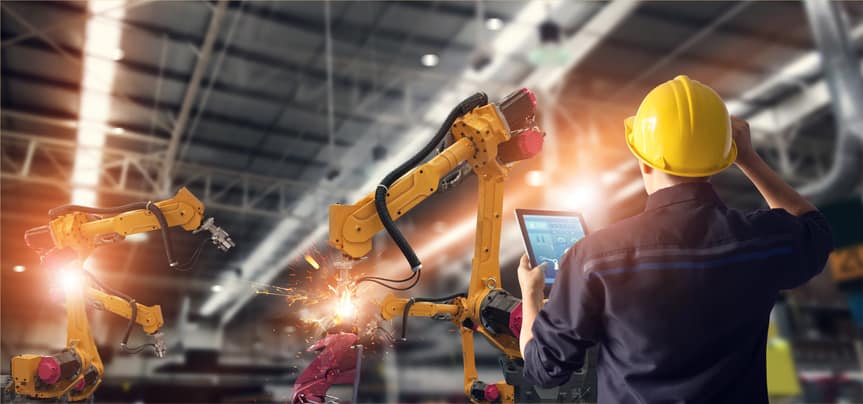 Manufacturers that shift IT thinking to a new, real-time enterprise data strategy - with IoT, analytics and AI at the core - will be the ones that rise above their competitors, says Ravi Krishnamoorthi, head of Manufacturing and Automotive Solutions at Fujitsu in EMEIA
Manufacturers that shift IT thinking to a new, real-time enterprise data strategy - with IoT, analytics and AI at the core - will be the ones that rise above their competitors, says Ravi Krishnamoorthi, head of Manufacturing and Automotive Solutions at Fujitsu in EMEIA
The global manufacturing industry is undergoing unprecedented transformation; new technologies are completely disrupting the way in which manufacturers operate. As a result, it’s increasingly important for businesses to improve productivity and increase efficiency across the entire value chain. To do this, businesses need the right data insights at the right time to achieve the greatest advances in manufacturing.
This is where digital transformation becomes critical: new innovations from IoT and AI, to Blockchain and advanced analytics must become the foundation of the manufacturing sector of the future. This is key to revolutionising relationships with partners, suppliers and, ultimately, customers.
So how exactly can technology help the industry adapt to the current disruption?
The factory has evolved
The factory has changed drastically over the last 200 years, but even more so recently. It is no longer simply a box where you make things; the vast amount of data that is now available has made it so much more complex.
Indeed, the factory of today goes beyond the warehouse: it is now a seamless flow of data and processes that go from the field or quarry straight through to the consumer’s home. This, in turn, has created limitless possibilities that manufacturers must address this year. One of the outcomes of the unconstrained factory is that manufacturers are much more focused on the end user. With this comes a greater focus on creating insights; manufacturers now have the opportunity to grow their business by conveying data to the end user via a feedback loop. By intelligently connecting data, businesses can adjust supply lines far more dynamically, react faster to changes in the market, deliver tailored products, sidestep problems with stockpiling and safeguard themselves better from supply chain failures.
As communication with the consumer is now the focus for businesses, they need to stop thinking the factories end at their gates and instead, think through to the end of the value chain. If manufacturers can do this, the benefits of technology will go far beyond the factory floor. The beauty of digital technologies is that they enable manufacturers to capture the power of data and feed it back into the entire set of processes and relationships so that it can boost efficiency, productivity, cost-savings, and customer relationships and loyalty.
Data will create an entirely new way of pricing
You only have to look at the enormous value created by Facebook to understand that data is powerful stuff. In the manufacturing sector, there is similarly dramatic potential. Data has the ability to create new business models, stay ahead of market trends, and anticipate customers’ needs before they’re even conscious of them… The list goes on.
The most important outcome of all this data is that businesses are now able to reap the rewards of servitisation. Servitisation uses new technologies such as the Internet of Things (IoT) to ensure that engineers are alerted to any technical problems before they actually occur.
This is a signal towards where Industry 4.0 will take us – with data at its core. In 2019, the servitisation model will finally reach the mainstream; the result of this will be that manufacturers will refocus pricing on the outcome, not the product.

Digital has made things uncomfortable for many manufacturers, but the sharing model is taking this discomfort and delivering value. For example, look at jet engines. Currently, if a company wishes to buy a jet engine, they have to pay all the money flat out. What servitisation has enabled businesses to do is to adopt an ‘As a service’ approach, where they need not pay for the whole engine. Rather, the amount they pay will depend on how long the engine is in the air – as this data now becomes measurable.
The same process is happening within automotive manufacturing, which has disrupted the traditional third-party dealership in the motor trade. Author and economist Jeremy Rifkin predicted that in 25 years, “car sharing will be the norm and car ownership an anomaly”. As a result, the way in which manufacturers are leveraging data is changing too.
How to approach your data in 2019
Previously, businesses had to build a data warehousing capability, where historical data was used to answer the questions to support strategical decisions. However, in 2019, that will no longer be a differentiating factor. To adapt, businesses must approach their data in two ways.
Firstly, manufacturers must leverage the real-time data at their fingertips. Having insights into what is happening now, rather than analysing averages from the last 12 months, presents the opportunity to derive higher value from data and to make more informed, realistic decisions.
The second difference for businesses is that the initial problem or question isn’t immediately obvious. It is by examining the real-time data that you can discover your point of difference, and you can ask the right questions. By doing this, manufacturers can improve their process, price and margin; and they can do this at speed.
The manufacturers that can meet both these requirements, shift IT thinking to a new, real-time enterprise data strategy, with IoT, analytics and AI at the core, will be the ones that are lifted above their competitors.










Water Sector Talent Exodus Could Cripple The Sector
Well let´s do a little experiment. My last (10.4.25) half-yearly water/waste water bill from Severn Trent was £98.29. How much does not-for-profit Dŵr...